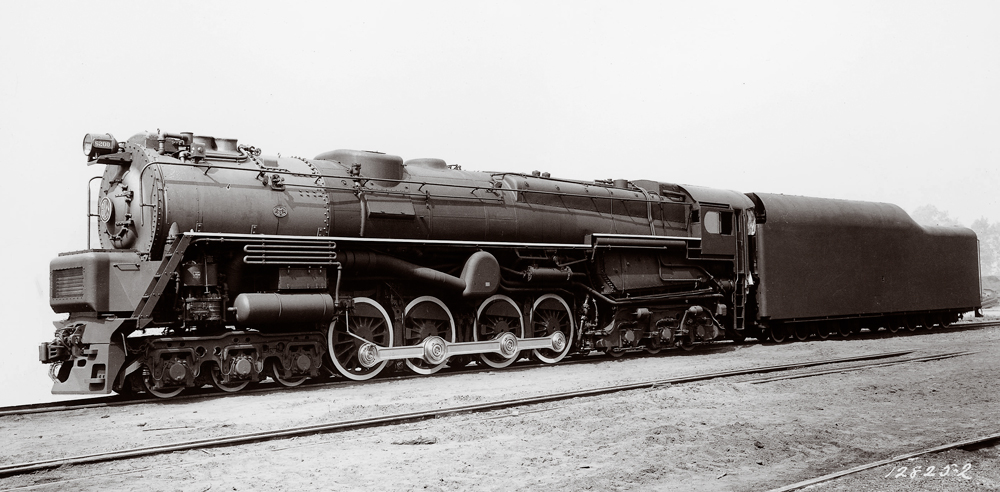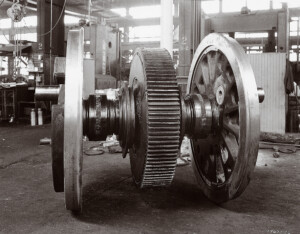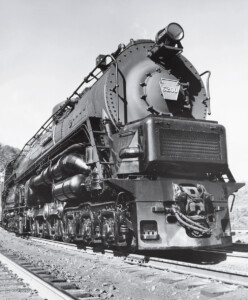Pennsylvania 6200 turbine locomotive was an experimental locomotive that served on passenger trains in Indiana and Ohio. But it is perhaps best known as the Lionel No. 671 Pennsylvania Turbine.

The first of several turbine projects the Pennsylvania considered was also the only one that produced an actual locomotive: steam-turbine-mechanical No. 6200. Pennsy ordered it from the Baldwin-Westinghouse team in the early 1940s, but wartime material restrictions delayed construction and increased the weight of the design. The sole member of PRR class S2 was completed in September 1944 with a 6-8-6 wheel arrangement, rather than 4-8-4 as first planned. It burned coal, of which PRR was the nation’s leading hauler.

The S2 looked much like a conventional steam locomotive, except that, instead of cylinders and main rods, it used turbines geared to the driving wheels. Steam was fed into a 6,900 hp turbine mounted on the locomotive’s right-hand side. The turbine powered a modified version of a marine gearbox driving the two center axles; siderods carried power to the outer two sets of driving wheels. This large turbine was for forward motion only; a smaller, 1,500 hp unit on the fireman’s side was used for reverse. While the turbine drive was a bold step, the S2 as a whole followed standard reciprocating steam-locomotive practice as closely possible.
Only the barest minimum of changes were made to accommodate the turbine. The boiler, for example, was little more than a conventional firetube type with no real turbine-specific modifications, apart from a 310-psi working pressure. This was indicative of the PRR’s desire to mate a regular boiler to the new turbine concept without making any allowances for the steam demand and voracious appetite for fuel that a turbine has. This was to be a large reason for the failure of all such steam-turbine designs.
This is because the steam turbine has a very low starting torque, so that it takes a large amount of steam to start such a locomotive under load. Unless the engineer is very careful, the turbine can literally use all the steam in the boiler. In addition, the turbine has a high steam demand even when the locomotive is sitting still, which meant high fuel consumption. For the best results with a steam turbine, the designers had to use a higher steam pressure than a conventional staybolted boiler could handle. It was for these reasons that such designs had little hope of success, and that many of the most knowledgeable engineers were writing off the steam turbine.

It was apparent soon after the Pennsylvania 6200 turbine locomotive hit the rails that it would not be worthy of duplication. While it was running out miles between Chicago and Crestline, Ohio, in the passenger pool, plans were made for a successor. By early 1945, the PRR and Westinghouse were promoting another new type of steam turbine. This was a 2-D+2-D streamlined unit having a pair of geared driver sets. It was claimed to be capable of 9,000 hp but was never built. Meanwhile, the S2 was stored in 1949, never to run again.














there is a very short silent video on youtube of the s2 moving without any cars. its the only one i could find. previous articles have the engine being scrapped in the 1950s. Norfolk and western did build a larger unit. ‘Jawn Henry’ that was coal fired steam electric. it was scrapped in 1954.
Where is it now? The article says it went into storage. Is it in Ohio?
Scrapped
was there ever a recording made of an operating S2 locomotive?
The British LMS Turbomotive was relatively successful even though it had a conventional boiler. At low speeds only a few of the six nozzles that provided steam to the turbine were opened, reducing the high steam demand on starting. It ran for 14 years until it had a major turbine failure and was then rebuilt as a conventional loco.